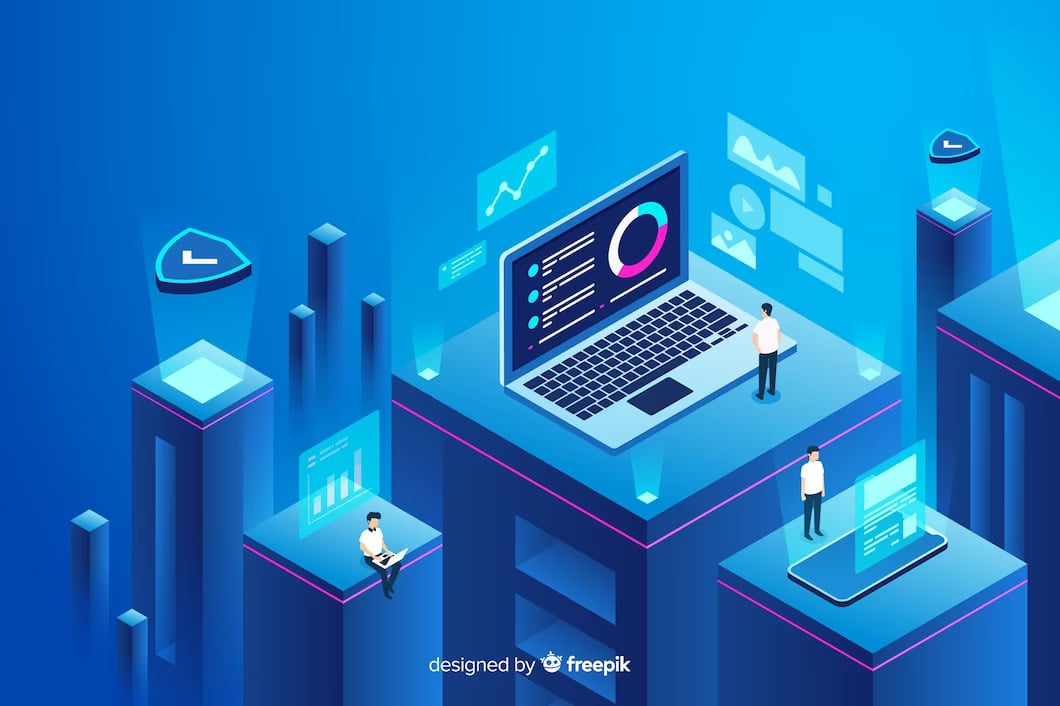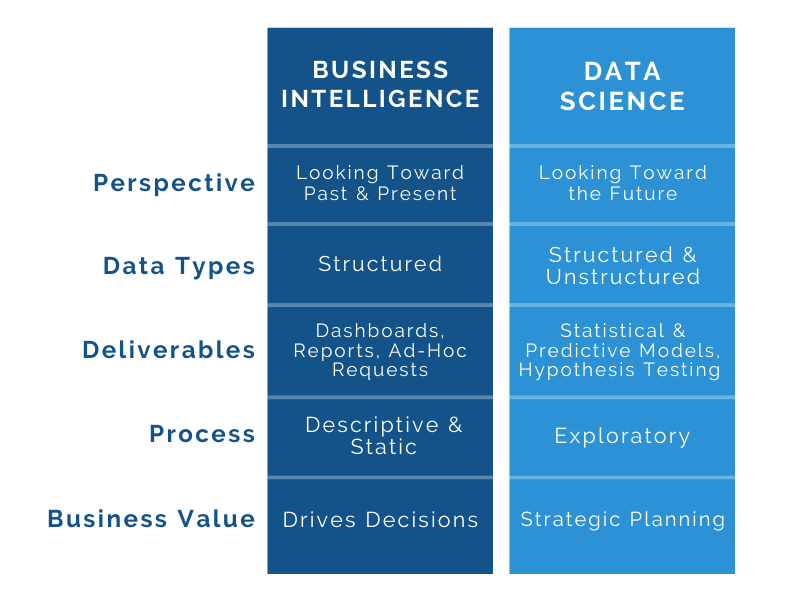In today’s business world, it seems like all decisions and strategies ultimately point back to one thing: data. However, how that data is being used to find value and produce insights from within the data stack is a different story. Business intelligence and data science are two terms often used interchangeably when talking about the who, what, why, and how of working with data.
While they both appear to work with data to solve problems and drive decision-making, what’s the real difference between the two? Let’s get back to the basics by diving into the similarities and differences of each when it comes to their core functions, deliverables, and overall role as it relates to data-driven decision-making.
What is Business Intelligence?
Business intelligence is developing and communicating strategic insights based on available business information to support decision-making. The purpose of business intelligence is to provide a clear understanding of an organization’s current and historical data. When BI was first introduced in the early 1960s, it was designed as a method of communicating information across business units. Since then, BI has evolved into advanced practices of data analysis but communication has remained at its core.
Additionally, BI is much more than processes and methods for analyzing data or answering specific business questions, it also includes the technologies behind those methods. These tools, often self-service, allow users to quickly visualize and understand business information.
Why is Business Intelligence Important?
Since data volumes are rapidly increasing, business intelligence is more essential than ever in providing a comprehensive snapshot of business information. This gives guidance towards informed decision-making and identifying areas of improvement, leading to greater organizational efficiency and an increased bottom line.
What is Data Science?
While there is no universally accepted definition of data science, it’s generally accepted as a field that embraces many disciplines, including statistics, advanced programming skills, and machine learning, in order to generate actionable insights from raw data.
In simple terms, data science is the process of obtaining value from a company’s data, usually to solve complex problems. It’s important to note that data science is still developing as a field and this definition is continually evolving with time.
Why is Data Science Important?
Data science is a guide through which companies are able to predict, prepare, and optimize their operations. Moreover, data science can be pivotal to the user experience, for many businesses data science is what allows them to offer personalized and tailored services. For instance, streaming services, such as Netflix and Hulu, are able to recommend entertainment options based on the user’s previous viewing history and taste preferences. Subscribers spend less time searching for what to watch and are able to easily find value amongst the hundreds of offerings, giving them a unique and personally curated experience. This is significant in that it increases customer retention while also enhancing the subscriber’s ease of use.
Business Intelligence vs. Data Science: What’s the Difference?
Generally speaking, business intelligence and data science both play a key role in producing any organization’s actionable insights. So where exactly is the line between the two? When does business intelligence end and data science begin?
BI and data science vary in a number of ways, from the type of data they’re working with to project deliverables and approaches. See the figure below for a visual distinction between the most common attributes of the two.
 Perspective
Perspective
Business intelligence is focused on the present while data science is looking towards the future and predicting what might happen next. BI works with historical data in order to determine a responsive course of action while data science creates predictive models that recognize future opportunities.
Data Types
Business intelligence works with structured data that is typically data warehoused or stored in data silos. Similarly, data science also works with structured data but predominantly is tasked with unstructured and semi-structured data, resulting in greater time dedicated towards cleaning and improving data quality.
Deliverables
Reports are the name of the game when it comes to business intelligence. Other deliverables for business intelligence include things like building dashboards and performing ad-hoc requests. Data science deliverables have the same end goal in mind but focus heavily on long-term and forward-looking projects. Projects will include building models in production rather than working from enterprise visualization tools. These projects also place a heavyweight on predicting future outcomes as opposed to BI’s focus on an organization’s current state.
Process
The distinction between the processes of each comes back to the perspective of time, similarly to how it influences the nature of deliverables. Business intelligence revolves around descriptive analytics, this is the first step of analysis and sets the stage for what has already happened. This is where non-technical business users can understand and interpret data through visualizations. For example, business managers can determine how many of item X was sold in July from promotional emails versus through direct website traffic. This then leads to additional digging and analysis regarding why some channels performed better than others.
Continuing with the previous example of item X, data science would take the exploratory approach. This means investigating the data through its attributes, hypothesis testing, and exploring common trends rather than answering business questions on performance first. Data scientists often start with a question or complex problem but this typically evolves upon exploration.
How Do BI & Data Science Drive Decisions?
While business intelligence and data science are both used to drive decisions, their perspective is central to determining the nature of decision-making. Due to the forward-looking nature of data science, it’s most often at the forefront of strategic planning and determining future courses of action. These decisions, though, are often preemptive rather than responsive. On the other hand, business intelligence aids decision-making based on previous performance or events that have occurred. Both disciplines fall under the umbrella of providing insights that will support business decisions, but the element of time is what distinguishes the two.
However, it’s important to note that this might not always be the case for every organization. The lines between the responsibilities of BI and data science teams are often blurred and vary from organization to organization.
Conclusion
Despite their differences, the end goal of business intelligence and data science is ultimately aligned. It’s important to note, though, the complementary perspectives of the two. Examining the past, present, and future through data remains vital to staying competitive and addressing key business problems.


 Perspective
Perspective
